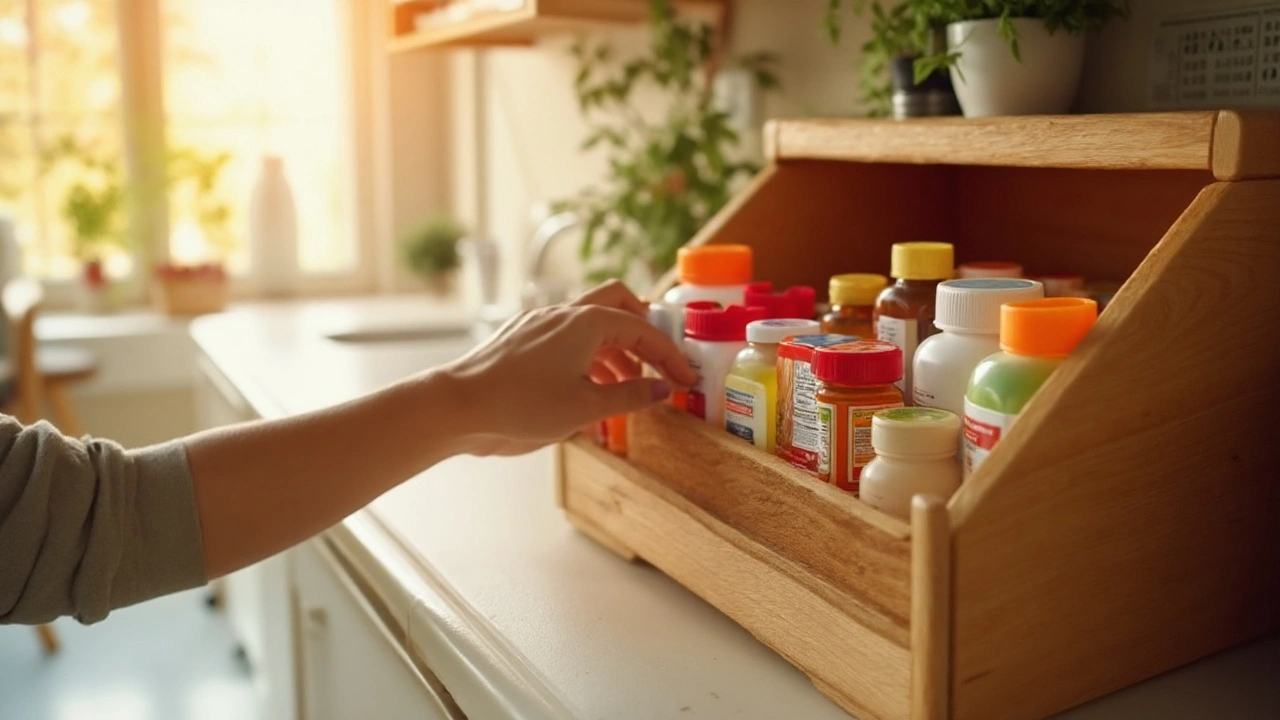Home Medicine Stock Calculator
Enter your current stock
Essential home medicines is a core set of over‑the‑counter (OTC) drugs that every household should keep stocked to handle everyday ailments quickly and safely. When a fever spikes, a sudden allergy flare hits, or a minor cut needs a quick remedy, having the right meds within arm's reach can prevent a trip to the pharmacy and ease anxiety. This guide walks you through the top medicines you really need, explains how to use them responsibly, and offers practical storage advice. By the end you’ll know exactly what to buy, how much to keep, and when to replace each item.
Why a Home Medicine Kit Matters
A well‑stocked kit bridges the gap between a minor symptom and a medical emergency. Studies from the American Academy of Family Physicians show that households with a basic OTC lineup experience 30% fewer urgent‑care visits for low‑severity issues. The kit also empowers you to act fast-time matters when controlling fever, stopping a bleed, or rehydrating a child with diarrhea. Moreover, a thoughtful collection reduces waste; you buy only what you need and rotate supplies before they expire.
Core Analgesics: Pain Relief and Fever Control
Most households need at least three pain‑relief options because each works slightly differently and has distinct safety profiles.
- Acetaminophen is an analgesic and antipyretic used to reduce mild to moderate pain and lower fever. Typical adult dose: 500‑1000mg every 4‑6hours, not exceeding 3000mg per day. Safe for most users but should be avoided in severe liver disease.
- Ibuprofen is a non‑steroidal anti‑inflammatory drug (NSAID) that relieves pain, inflammation, and fever. Recommended adult dose: 200‑400mg every 6‑8hours, max 1200mg daily for OTC use. Not suitable for people with stomach ulcers or chronic kidney issues.
- Aspirin is an NSAID with antiplatelet properties, useful for pain, fever, and cardiovascular protection in low‑dose form. Adult dose for pain: 325‑650mg every 4‑6hours, max 4000mg per day. Contraindicated in children with viral infections due to Reye’s syndrome risk.
Allergy & Cold Relief
Seasonal allergies and occasional colds can turn a good day into a miserable one. Two versatile OTC options cover most symptoms.
- Diphenhydramine is an antihistamine that counters sneezing, itchy eyes, and hives. Standard adult dose: 25‑50mg every 4‑6hours, not exceeding 300mg per day. It can cause drowsiness, so reserve it for nighttime or when you don’t need to drive.
- Dextromethorphan is a cough suppressant that works on the brain’s cough center to reduce dry, hacking coughs. Typical adult dose: 10‑20mg every 4hours, max 120mg per day. Avoid combining with other cough medicines that contain codeine or similar agents.
Digestive Aids
Upset stomachs, heartburn, and diarrhea strike at the worst moments. Covering the basics means fewer trips to urgent care.
- Calcium carbonate is an antacid that neutralizes stomach acid quickly. One tablet (500mg) provides relief within minutes; repeat every 2‑4hours, not exceeding 2g per day.
- Loperamide is an anti‑diarrheal that slows intestinal motility. Adults can take 2mg after the first loose stool, then 2mg after each subsequent stool, up to 8mg in 24hours.
- Oral Rehydration Salts (ORS) are a precise blend of glucose, sodium, potassium, and citrate designed to rehydrate after vomiting or diarrhea. Dissolve one packet in 200ml of clean water and sip slowly; repeat as needed.

Topical Care: Skin Irritations and Minor Wounds
Cuts, burns, rashes, and insect bites are inevitable. Two OTC topical agents handle most situations.
- Hydrocortisone 1% cream is a mild steroid that reduces itching, redness, and inflammation from eczema, poison‑ivy, or insect bites. Apply a thin layer up to 4 times daily for no more than 7days without doctor supervision.
- Bacitracin ointment is a topical antibiotic that protects minor cuts, scrapes, and abrasions from bacterial infection. Use a small amount on the cleaned wound 1‑3 times per day for up to 5days.
Analgesic Comparison Table
| Medicine | Onset (minutes) | Typical Duration (hours) | Max Daily Dose (adult) | Main Contraindications |
|---|---|---|---|---|
| Acetaminophen | 30‑60 | 4‑6 | 3000mg | Liver disease, alcohol abuse |
| Ibuprofen | 15‑30 | 6‑8 | 1200mg (OTC) | Stomach ulcer, kidney disease |
| Aspirin | 15‑30 | 4‑6 | 4000mg | Bleeding disorders, Reye’s syndrome in children |
How to Store & Rotate Your Medicines
Proper storage extends shelf life and preserves potency. Keep all medicines in a cool, dry place away from direct sunlight-ideally a cabinet outside the bathroom, where humidity spikes.
- Check expiration dates every three months. Move any product within six months of expiry to the front of the cabinet and replace it.
- Store child‑proof containers on a high shelf out of reach of kids.
- Separate liquid formulations (e.g., ORS, liquid acetaminophen) from tablets to avoid accidental mixing.
- Maintain a simple log (paper or digital) noting purchase date, expiry, and quantity on hand.
- When a medicine is used, record the amount and replenish to keep a consistent stock level.
Using these habits ensures you never run out of a critical dose when you need it most.
Related Concepts and Next Steps
This article sits within the broader home emergency preparedness cluster. While we focused on the core OTC lineup, you might also explore:
- First‑aid basics: bandages, splints, and emergency contact sheets.
- Home safety devices: smoke detectors, carbon‑monoxide alarms, and fire extinguishers.
- Advanced medical supplies for chronic conditions (e.g., glucometers for diabetics).
Each of these topics builds on the foundation of a reliable medicine kit and helps you create a truly resilient household.
Frequently Asked Questions
How many tablets of acetaminophen should I keep at home?
A good baseline is a bottle of 100500‑mg tablets. That covers up to 10days of maximum adult dosing without exceeding the 3000mg daily limit. Adjust quantity if you have more than two adults or children who need liquid formulations.
Can I substitute ibuprofen with naproxen for home use?
Naproxen works similarly to ibuprofen but has a longer half‑life, meaning fewer doses per day. However, it isn’t sold OTC in as many strengths and has a higher risk of stomach irritation. If you prefer a longer‑acting NSAID, keep a low‑dose naproxen pack, but always follow the label and consult a pharmacist.
Is it safe to give diphenhydramine to toddlers?
Diphenhydramine is approved for children over 2years in pediatric‑dose formulations. For younger kids, use a pediatrician‑recommended antihistamine like cetirizine. Always measure the dose with the provided syringe or dropper.
How often should I replace my oral rehydration salts?
ORS packets have a long shelf life-typically 3‑5years-but check the packaging for a specific expiry. If a packet looks discolored or clumped, discard it even if the date hasn’t passed.
Can I use bacitracin on animal wounds?
Yes, bacitracin is safe for minor cuts on dogs and cats, but avoid applying it to deep puncture wounds or large areas. If the animal shows signs of infection (redness, swelling, pus), see a veterinarian.

